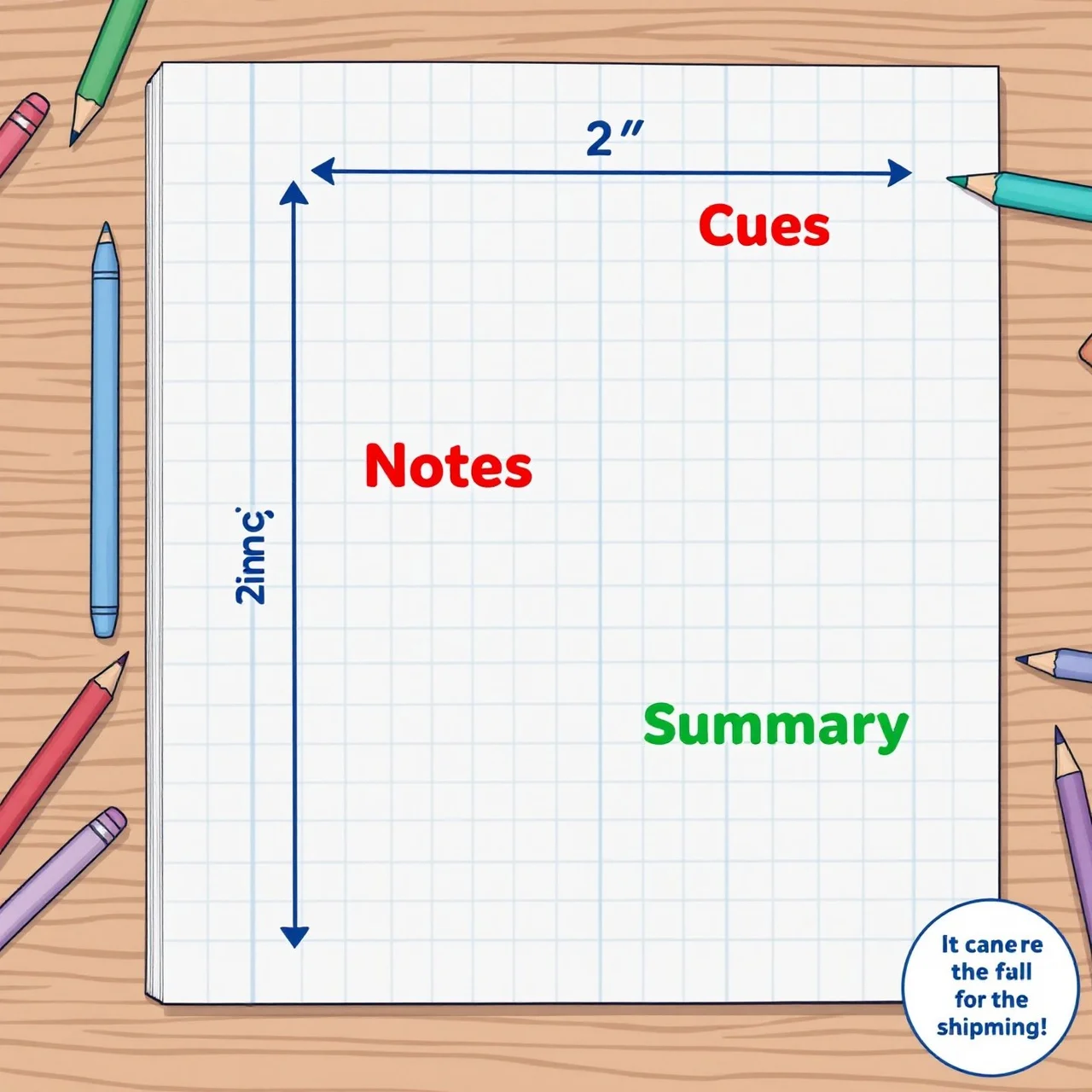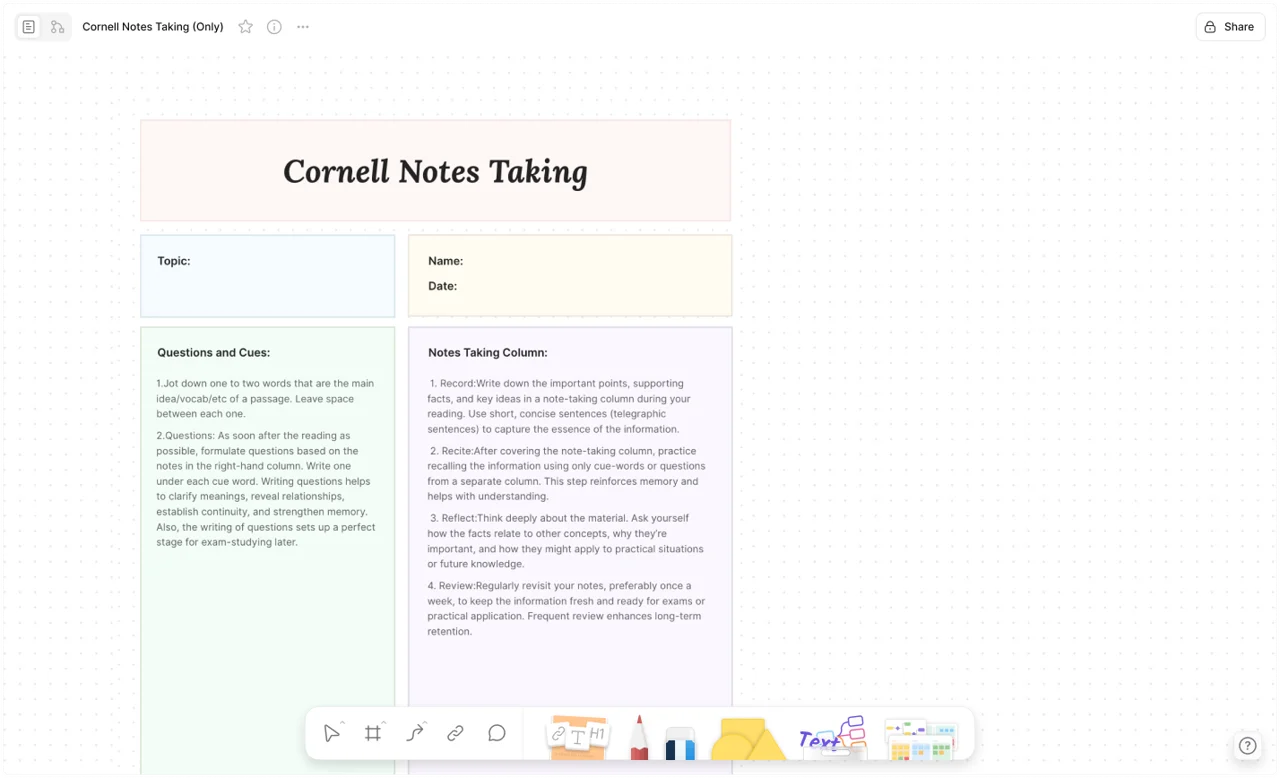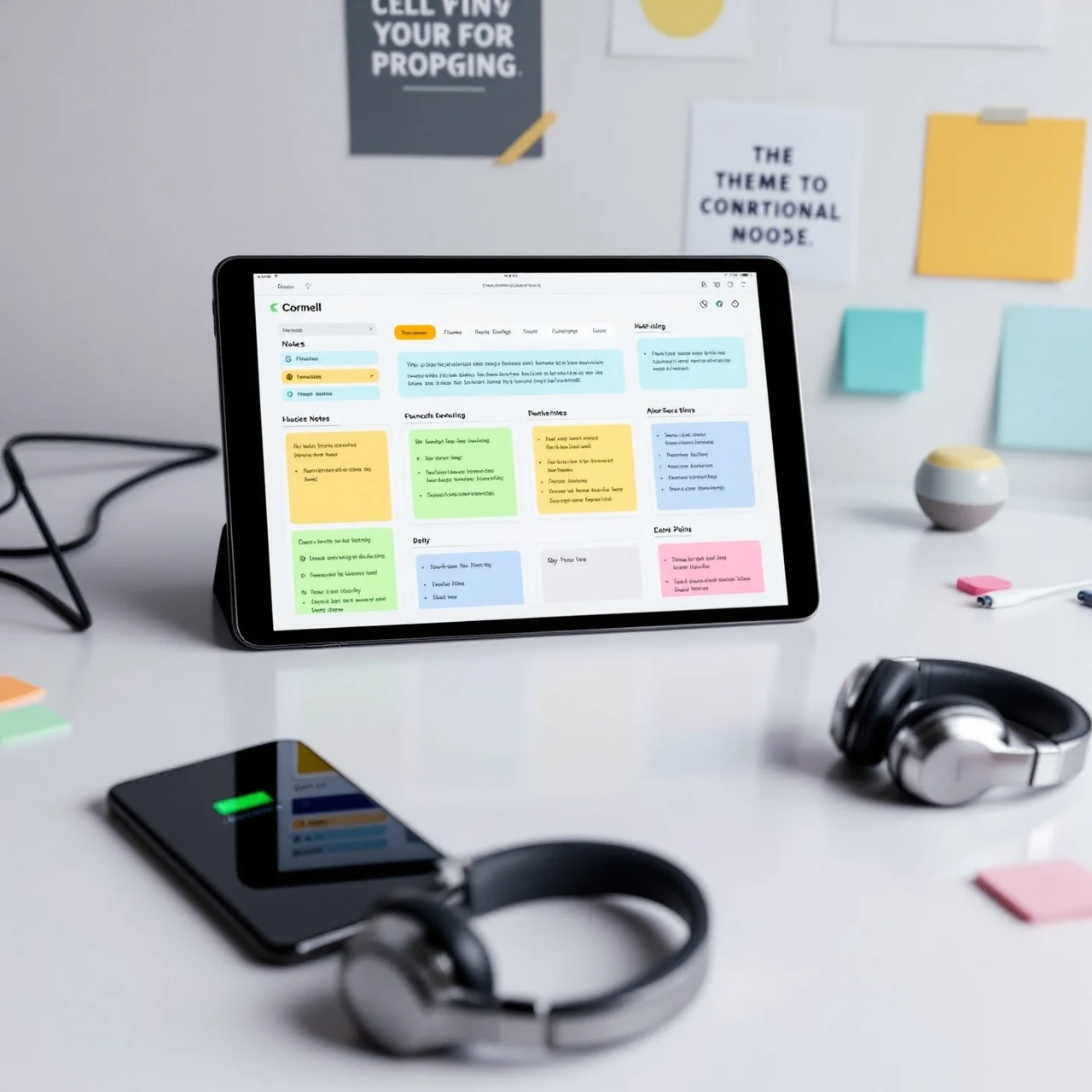--- title: "Best Cornell Notes Notebooks to Elevate Your Study Game" author: "Allen" tags: Content slug: cornell-notes-notebook description: "Boost study efficiency with the Cornell Notes system. Discover top notebooks and digital templates for organized, effective note-taking." created: 2024-12-11 layout: blog publish: true --- <img src="https://app.affine.pro/api/workspaces/qf73AF6vzWphbTJdN7KiX/blobs/a0TKbLywUMbtLI3fHHlEYtFK-TtEY-Z4jcB6EE_GI6Q=.webp" width="2400" height="1260" crossorigin="anonymous" /> ## Introduction to the Cornell Notes System Imagine a note-taking method that not only organizes your thoughts but also enhances your understanding and retention of information. This is precisely what the Cornell Notes System offers. Developed by Professor Walter Pauk at Cornell University in the 1950s, this system has become a cornerstone for effective learning strategies. But what makes it so beneficial? The [Cornell Notes System](https://affine.pro/blog/the-cornell-notes-template-and-system-learning-tips) is structured to facilitate active engagement with the material. It divides the page into three distinct sections: a wide right-hand column for detailed notes, a narrow left-hand column for cues or keywords, and a summary section at the bottom. This layout encourages students to actively process information, rather than passively transcribe it. One of the [key benefits](https://lsc.cornell.edu/how-to-study/taking-notes/cornell-note-taking-system/) of this system is its ability to enhance memory retention. By organizing notes into questions and summaries, students can easily review and reinforce their learning. This method also encourages critical thinking through the formulation of questions and summaries, making it a powerful tool for both classroom and independent study. For many, adopting a Cornell notes notebook can transform their learning experience. The structured format not only aids in organizing thoughts but also streamlines the review process, leading to improved academic performance. As we explore the best Cornell notes notebooks available, you’ll discover how this system can be tailored to fit your unique study needs.  ## Understanding the Cornell Notes System The Cornell Notes System, a pioneering approach to note-taking, was developed in the 1950s by Walter Pauk, an education professor at Cornell University. This method emerged as a response to the need for a more effective way to capture and review lecture notes, and it quickly gained popularity due to its structured yet flexible format. But what exactly makes this system so enduringly effective? At its core, the Cornell Notes System is designed to streamline the note-taking process by dividing the page into three key sections. Let's break down this structure: ### The Note Taking Area The largest section of the page is the Note Taking Area, where students jot down the main points of a lecture or reading material. This section encourages the use of concise sentences, symbols, and abbreviations to efficiently capture information. The focus here is on actively engaging with the material, which aids in comprehension and retention. ### The Cue Column Adjacent to the Note Taking Area is the Cue Column. This narrow section is reserved for keywords, questions, or comments that relate to the notes. It's typically filled in after the initial note-taking session, serving as a tool for review and self-testing. By summarizing the main points into prompts, students can enhance their recall and understanding through active engagement with the material. ### The Summary Section Located at the bottom of the page, the Summary Section is where students synthesize the content into one or two sentences. This final step not only reinforces what has been learned but also helps highlight the core message of the lecture or reading. Summarizing aids in the synthesis of information, enabling students to connect new knowledge with existing understanding. The structured format of the Cornell Notes System provides a comprehensive framework for organizing and reviewing information, making it a valuable tool for students at all levels. As we move forward, we will explore the specific benefits of using a Cornell Notes notebook, highlighting how this method can transform your study habits and enhance learning outcomes.  ## Benefits of Using a Cornell Notes Notebook Imagine having a note-taking system that not only organizes your thoughts but also significantly boosts your ability to recall information. This is where the Cornell Notes notebook shines. By leveraging the structured format of the Cornell Notes system, these notebooks provide a multitude of benefits that enhance both learning and retention. ### Enhanced Organization The structured layout of a Cornell Notes notebook inherently promotes better organization. With its distinct sections for notes, cues, and summaries, students are guided to compartmentalize information logically. This organization allows for clearer thought processes and easier retrieval of information, which is crucial during study sessions or when preparing for exams. The cue column, for instance, serves as a quick-reference guide, making it easier to locate key concepts and questions at a glance. ### Improved Retention One of the most significant benefits of using a Cornell Notes notebook is the enhancement of memory retention. Studies, such as those on the [Curve of Forgetting](https://centenaryshs.eq.edu.au/Supportandresources/Formsanddocuments/Documents/Curriculum%20-%20Senior%20Schooling/cornell-notes-and-curve-of-forgetting.pdf), show that without regular review, much of what we learn is quickly forgotten. The Cornell Notes system combats this by encouraging regular review and summarization, which reinforces learning and helps embed information into long-term memory. By revisiting notes and using the cue column for active recall, students can significantly improve their retention rates. ### Facilitated Review Process The Cornell Notes notebook also streamlines the review process. The summarization section at the bottom of each page compels students to distill their notes into concise summaries, which are invaluable for quick reviews. This process not only aids in understanding the material more deeply but also makes it easier to prepare for exams. By regularly engaging with their notes, students can ensure that they are continuously reinforcing their learning, thus making the study process more efficient and less time-consuming. In essence, the Cornell Notes notebook is more than just a tool for jotting down information; it is a comprehensive system that enhances note-taking efficiency and learning outcomes. As we continue, we'll delve into how to select the right Cornell Notes notebook to further optimize your study habits. ## Selecting the Right Cornell Notes Notebook Choosing the best Cornell notes notebook can be a game-changer in your study routine, but with so many options available, where do you start? Let's explore some essential factors to consider when selecting the perfect notebook to complement your study habits. ### Paper Quality When it comes to paper quality, you'll want to ensure that the pages are thick enough to prevent ink bleed-through, especially if you prefer using pens or markers. Look for notebooks with premium paper, often labeled as 80gsm or higher, which provides a smooth writing experience and durability. High-quality paper not only enhances the writing process but also ensures your notes remain legible and intact over time. ### Binding Types The binding of your notebook can significantly impact its usability and durability. Spiral binding, for instance, allows the notebook to lay flat and offers the flexibility to fold pages back, which is ideal for taking notes in tight spaces or on the go. According to [Syloon](https://www.syloon.com/notebook-binding-guide-styles-techniques-and-tips) , spiral binding is a favorite for its ease of use and durability. On the other hand, stitched or sewn bindings provide a more traditional look and are known for their longevity and ability to withstand frequent handling. If you’re looking for a notebook that maintains a professional appearance, Wire-O binding could be a suitable choice as it combines durability with a polished finish. ### Size Considerations Size is another crucial factor when selecting a Cornell notes notebook. Standard sizes like 8.5 x 11 inches are perfect for detailed note-taking and offer ample space for organizing thoughts. However, if portability is a priority, consider a smaller size that fits easily into a backpack or purse. The right size will depend on your specific needs and how you plan to use the notebook. For classroom settings, larger notebooks might be preferable, while smaller ones are ideal for quick notes during meetings or study sessions on the go. By carefully considering these factors—paper quality, binding type, and size—you can select a Cornell notes notebook that not only meets your practical needs but also enhances your overall study efficiency. As we continue, we'll look at some of the top Cornell notes notebooks available online, helping you make an informed choice.  ## Top Cornell Notes Notebooks Available Online When it comes to enhancing your study efficiency, choosing the right Cornell notes notebook can make a significant difference. With numerous options available online, it’s essential to compare features to find the best fit for your needs. Let's explore some of the top-rated Cornell notes notebooks available from popular retailers like Amazon, Staples, Target, Walmart, and Office Depot, as well as the innovative AFFiNE's [Cornell Notes Template](https://affine.pro/templates/cornell-note-template). ### Comparison of Popular Cornell Notes Notebooks |Notebook|Features|Price Range|Availability| |---|---|---|---| |[Moleskine Cahier Journal](https://www.amazon.com)|Soft cover, 160 pages, 7.5 x 9.5 inches, minimalist design|Approx. $20 for two|Amazon| |[Oxford FocusNotes](https://www.amazon.com)|Thick paper, perforated pages, 3-hole punching|Approx. $10 per notebook|Amazon, Staples| |[Gakken Cornell Notebook](https://www.walmart.com)|Lightweight, B5 size, graph rule in notes area|Approx. $8 for three|Walmart, Amazon Japan| |[Office Depot Brand Cornell Notebook](https://www.officedepot.com)|Durable cover, spiral binding, variety of sizes|Varies|Office Depot| ### AFFiNE's Cornell Notes Template: A Digital Alternative  In addition to physical notebooks, digital templates like the [AFFiNE Cornell Notes Template](https://affine.pro/templates/cornell-note-template) offer a modern twist on traditional note-taking. This template provides a structured format that includes sections for detailed notes, cues, and summaries, making it an ideal tool for students and professionals alike. The AFFiNE template is not just a digital note-taking tool but a comprehensive system that enhances productivity and learning efficiency. Whether you prefer the tactile experience of a physical notebook or the versatility of a digital platform, there are plenty of options to suit your style. As we move forward, consider how these tools can be integrated into your study routine to maximize your academic performance. ## Digital Alternatives: Cornell Notes Templates In today's digital age, the traditional method of note-taking is being revolutionized by technology. If you're looking for a flexible and efficient way to manage your notes, digital Cornell Notes templates offer a compelling alternative to physical notebooks. One standout option is the [AFFiNE Cornell Notes Template](https://affine.pro/templates/cornell-note-template) , which brings a modern twist to this classic system. ### Features of AFFiNE's Digital Template The AFFiNE template enhances the traditional Cornell method with a suite of digital features designed to maximize productivity and learning efficiency. Here are some of its standout capabilities: * **Editable and Expandable Notes:** Easily adjust your notes as you gather more information or refine your understanding. * **Cross-Linking:** Connect related ideas across different notes, facilitating a deeper understanding of complex topics. * **Multimedia Integration:** Embed images, videos, and audio files directly into your notes to enrich your learning experience. * **Real-Time Collaboration:** Share and collaborate on notes with peers, making group study sessions more interactive and efficient. * **Tagging and Filtering:** Organize your notes with tags for quick retrieval and efficient study sessions. * **Version History:** Track changes and revert to previous versions if necessary, ensuring your notes are always accurate and up-to-date. * **Synchronization:** Access your notes across multiple devices, ensuring you can study anytime, anywhere. These features make the AFFiNE template not only a digital note-taking tool but a comprehensive system for managing and reviewing information. ### Other Online Platforms Besides AFFiNE, there are various platforms offering printable Cornell notes templates that can be customized to fit your note-taking style. Websites like [TemplateLab](https://templatelab.com/cornell-notes/) provide downloadable templates in formats like Word, Excel, and PDF, allowing you to tailor the layout to your preferences. These templates are particularly useful for students who prefer a structured approach without the need for digital devices. Whether you choose a digital or printable template, these tools are designed to enhance your study efficiency by providing a structured and organized approach to note-taking. As we continue, we'll explore best practices for using a Cornell Notes notebook effectively, ensuring you get the most out of this powerful system.  ## Best Practices for Maximizing Your Cornell Notes Notebook To truly harness the potential of a Cornell Notes notebook, it's essential to employ strategies that enhance both your note-taking and learning processes. Here are some best practices to help you maximize your use of this powerful tool. ### Engage Actively During Note-Taking Effective note-taking begins with active engagement. During lectures or while reading, focus on understanding the material rather than merely transcribing it. Use the Note Taking Area to jot down key points and concepts in your own words. This not only aids comprehension but also makes it easier to recall information later. You’ll notice that summarizing complex ideas in concise terms helps solidify your understanding. ### Consistent Review for Better Retention One of the most significant advantages of the Cornell Notes system is its facilitation of regular review. After your initial note-taking session, revisit your notes to fill in the Cue Column with questions or keywords. These prompts can serve as a basis for self-quizzing, helping reinforce your memory and understanding. Consistent review sessions are crucial for embedding information into long-term memory, turning passive notes into active study tools. ### Personalize Your Cue and Summary Sections Every learner is different, and personalizing your notes can significantly enhance their effectiveness. Tailor the Cue Column and Summary Section to fit your learning style. For instance, if you're a visual learner, consider using symbols or drawings to highlight important points. In the Summary Section, write a brief overview in your own words to encapsulate the main ideas, making it easier to review and recall information later. Imagine being able to glance at a summary and instantly trigger a memory of the detailed notes. ### Utilize Technology Wisely Incorporating digital tools can further enhance your note-taking efficiency. If you're using a digital Cornell Notes notebook, take advantage of features like tagging, cross-linking, and multimedia integration to make your notes more dynamic and interactive. These tools can provide additional layers of understanding and make it easier to organize and retrieve information. By adopting these practices, you can transform your Cornell Notes notebook into a comprehensive study aid that not only organizes your thoughts but also enhances your learning and retention. As you continue to refine your approach, you'll find that these strategies make the Cornell Notes system an indispensable part of your academic toolkit. ## Conclusion As we've explored throughout this article, the Cornell Notes system stands out as a robust method for enhancing study efficiency. By structuring notes into distinct sections for recording, cueing, and summarizing, it fosters a deeper understanding and retention of material. This system not only organizes your thoughts but also transforms the way you engage with information, making learning more interactive and effective. Recapping its benefits, the Cornell Notes system encourages active learning and critical thinking. By regularly reviewing and summarizing notes, you reinforce your memory, making it easier to recall information during exams or discussions. This structured approach is not only beneficial for students but also for professionals who need to manage and synthesize large amounts of information efficiently. In the digital age, tools like the [AFFiNE Cornell Notes Template](https://affine.pro/templates/cornell-note-template) bring this classic method into the modern era. With features like editable notes, multimedia integration, and real-time collaboration, AFFiNE provides a versatile platform that adapts to various learning styles and needs. Its user-friendly interface and customizable options make it an invaluable tool for anyone looking to optimize their note-taking strategy. Whether you choose a traditional notebook or a digital template, embracing the Cornell Notes system can significantly enhance your study habits. As you consider integrating this method into your routine, remember that the key lies in consistent practice and personalization. The benefits of the Cornell Notes system are clear, and with tools like AFFiNE, you can tailor this powerful method to suit your unique learning journey. ## FAQs about Cornell Notes Notebooks ### 1. What are 2 disadvantages to Cornell notes? Cornell notes can be time-consuming to set up and may not be ideal for subjects requiring visual elements like diagrams. Additionally, the space can feel cramped for handwritten notes. ### 2. What are the 5 steps of Cornell notes? The Cornell Method involves five steps: record notes during lectures, reduce them into key points, recite from memory, reflect on the material, and review regularly for better retention. ### 3. What is a Cornell notes notebook? A Cornell notes notebook is designed with a structured layout to help organize notes effectively, featuring sections for detailed notes, cues, and summaries, enhancing study efficiency. ### 4. Is there a Cornell notes template for OneNote? Yes, OneNote supports the Cornell method. You can create a layout with a main notes area, a cue column for questions, and a summary section, allowing for organized digital note-taking. ### 5. How do digital Cornell notes templates enhance learning? Digital templates like AFFiNE offer features such as multimedia integration, real-time collaboration, and cross-linking, making them versatile tools for dynamic and interactive learning. |Column 1|Title| |---|---|
title: "Best Cornell Notes Notebooks to Elevate Your Study Game"
author: "Allen"
tags: Content
slug: cornell-notes-notebook
description: "Boost study efficiency with the Cornell Notes system. Discover top notebooks and digital templates for organized, effective note-taking."
created: 2024-12-11
layout: blog
publish: true

Introduction to the Cornell Notes System
Imagine a note-taking method that not only organizes your thoughts but also enhances your understanding and retention of information. This is precisely what the Cornell Notes System offers. Developed by Professor Walter Pauk at Cornell University in the 1950s, this system has become a cornerstone for effective learning strategies. But what makes it so beneficial?
The Cornell Notes System is structured to facilitate active engagement with the material. It divides the page into three distinct sections: a wide right-hand column for detailed notes, a narrow left-hand column for cues or keywords, and a summary section at the bottom. This layout encourages students to actively process information, rather than passively transcribe it.
One of the key benefits of this system is its ability to enhance memory retention. By organizing notes into questions and summaries, students can easily review and reinforce their learning. This method also encourages critical thinking through the formulation of questions and summaries, making it a powerful tool for both classroom and independent study.
For many, adopting a Cornell notes notebook can transform their learning experience. The structured format not only aids in organizing thoughts but also streamlines the review process, leading to improved academic performance. As we explore the best Cornell notes notebooks available, you’ll discover how this system can be tailored to fit your unique study needs.

Understanding the Cornell Notes System
The Cornell Notes System, a pioneering approach to note-taking, was developed in the 1950s by Walter Pauk, an education professor at Cornell University. This method emerged as a response to the need for a more effective way to capture and review lecture notes, and it quickly gained popularity due to its structured yet flexible format. But what exactly makes this system so enduringly effective?
At its core, the Cornell Notes System is designed to streamline the note-taking process by dividing the page into three key sections. Let's break down this structure:
The Note Taking Area
The largest section of the page is the Note Taking Area, where students jot down the main points of a lecture or reading material. This section encourages the use of concise sentences, symbols, and abbreviations to efficiently capture information. The focus here is on actively engaging with the material, which aids in comprehension and retention.
The Cue Column
Adjacent to the Note Taking Area is the Cue Column. This narrow section is reserved for keywords, questions, or comments that relate to the notes. It's typically filled in after the initial note-taking session, serving as a tool for review and self-testing. By summarizing the main points into prompts, students can enhance their recall and understanding through active engagement with the material.
The Summary Section
Located at the bottom of the page, the Summary Section is where students synthesize the content into one or two sentences. This final step not only reinforces what has been learned but also helps highlight the core message of the lecture or reading. Summarizing aids in the synthesis of information, enabling students to connect new knowledge with existing understanding.
The structured format of the Cornell Notes System provides a comprehensive framework for organizing and reviewing information, making it a valuable tool for students at all levels. As we move forward, we will explore the specific benefits of using a Cornell Notes notebook, highlighting how this method can transform your study habits and enhance learning outcomes.

Benefits of Using a Cornell Notes Notebook
Imagine having a note-taking system that not only organizes your thoughts but also significantly boosts your ability to recall information. This is where the Cornell Notes notebook shines. By leveraging the structured format of the Cornell Notes system, these notebooks provide a multitude of benefits that enhance both learning and retention.
Enhanced Organization
The structured layout of a Cornell Notes notebook inherently promotes better organization. With its distinct sections for notes, cues, and summaries, students are guided to compartmentalize information logically. This organization allows for clearer thought processes and easier retrieval of information, which is crucial during study sessions or when preparing for exams. The cue column, for instance, serves as a quick-reference guide, making it easier to locate key concepts and questions at a glance.
Improved Retention
One of the most significant benefits of using a Cornell Notes notebook is the enhancement of memory retention. Studies, such as those on the Curve of Forgetting, show that without regular review, much of what we learn is quickly forgotten. The Cornell Notes system combats this by encouraging regular review and summarization, which reinforces learning and helps embed information into long-term memory. By revisiting notes and using the cue column for active recall, students can significantly improve their retention rates.
Facilitated Review Process
The Cornell Notes notebook also streamlines the review process. The summarization section at the bottom of each page compels students to distill their notes into concise summaries, which are invaluable for quick reviews. This process not only aids in understanding the material more deeply but also makes it easier to prepare for exams. By regularly engaging with their notes, students can ensure that they are continuously reinforcing their learning, thus making the study process more efficient and less time-consuming.
In essence, the Cornell Notes notebook is more than just a tool for jotting down information; it is a comprehensive system that enhances note-taking efficiency and learning outcomes. As we continue, we'll delve into how to select the right Cornell Notes notebook to further optimize your study habits.
Selecting the Right Cornell Notes Notebook
Choosing the best Cornell notes notebook can be a game-changer in your study routine, but with so many options available, where do you start? Let's explore some essential factors to consider when selecting the perfect notebook to complement your study habits.
Paper Quality
When it comes to paper quality, you'll want to ensure that the pages are thick enough to prevent ink bleed-through, especially if you prefer using pens or markers. Look for notebooks with premium paper, often labeled as 80gsm or higher, which provides a smooth writing experience and durability. High-quality paper not only enhances the writing process but also ensures your notes remain legible and intact over time.
Binding Types
The binding of your notebook can significantly impact its usability and durability. Spiral binding, for instance, allows the notebook to lay flat and offers the flexibility to fold pages back, which is ideal for taking notes in tight spaces or on the go. According to Syloon , spiral binding is a favorite for its ease of use and durability. On the other hand, stitched or sewn bindings provide a more traditional look and are known for their longevity and ability to withstand frequent handling. If you’re looking for a notebook that maintains a professional appearance, Wire-O binding could be a suitable choice as it combines durability with a polished finish.
Size Considerations
Size is another crucial factor when selecting a Cornell notes notebook. Standard sizes like 8.5 x 11 inches are perfect for detailed note-taking and offer ample space for organizing thoughts. However, if portability is a priority, consider a smaller size that fits easily into a backpack or purse. The right size will depend on your specific needs and how you plan to use the notebook. For classroom settings, larger notebooks might be preferable, while smaller ones are ideal for quick notes during meetings or study sessions on the go.
By carefully considering these factors—paper quality, binding type, and size—you can select a Cornell notes notebook that not only meets your practical needs but also enhances your overall study efficiency. As we continue, we'll look at some of the top Cornell notes notebooks available online, helping you make an informed choice.

Top Cornell Notes Notebooks Available Online
When it comes to enhancing your study efficiency, choosing the right Cornell notes notebook can make a significant difference. With numerous options available online, it’s essential to compare features to find the best fit for your needs. Let's explore some of the top-rated Cornell notes notebooks available from popular retailers like Amazon, Staples, Target, Walmart, and Office Depot, as well as the innovative AFFiNE's Cornell Notes Template.
Comparison of Popular Cornell Notes Notebooks
| Notebook | Features | Price Range | Availability |
|---|---|---|---|
| Moleskine Cahier Journal | Soft cover, 160 pages, 7.5 x 9.5 inches, minimalist design | Approx. $20 for two | Amazon |
| Oxford FocusNotes | Thick paper, perforated pages, 3-hole punching | Approx. $10 per notebook | Amazon, Staples |
| Gakken Cornell Notebook | Lightweight, B5 size, graph rule in notes area | Approx. $8 for three | Walmart, Amazon Japan |
| Office Depot Brand Cornell Notebook | Durable cover, spiral binding, variety of sizes | Varies | Office Depot |
AFFiNE's Cornell Notes Template: A Digital Alternative

In addition to physical notebooks, digital templates like the AFFiNE Cornell Notes Template offer a modern twist on traditional note-taking. This template provides a structured format that includes sections for detailed notes, cues, and summaries, making it an ideal tool for students and professionals alike.
The AFFiNE template is not just a digital note-taking tool but a comprehensive system that enhances productivity and learning efficiency. Whether you prefer the tactile experience of a physical notebook or the versatility of a digital platform, there are plenty of options to suit your style. As we move forward, consider how these tools can be integrated into your study routine to maximize your academic performance.
Digital Alternatives: Cornell Notes Templates
In today's digital age, the traditional method of note-taking is being revolutionized by technology. If you're looking for a flexible and efficient way to manage your notes, digital Cornell Notes templates offer a compelling alternative to physical notebooks. One standout option is the AFFiNE Cornell Notes Template , which brings a modern twist to this classic system.
Features of AFFiNE's Digital Template
The AFFiNE template enhances the traditional Cornell method with a suite of digital features designed to maximize productivity and learning efficiency. Here are some of its standout capabilities:
-
Editable and Expandable Notes: Easily adjust your notes as you gather more information or refine your understanding.
-
Cross-Linking: Connect related ideas across different notes, facilitating a deeper understanding of complex topics.
-
Multimedia Integration: Embed images, videos, and audio files directly into your notes to enrich your learning experience.
-
Real-Time Collaboration: Share and collaborate on notes with peers, making group study sessions more interactive and efficient.
-
Tagging and Filtering: Organize your notes with tags for quick retrieval and efficient study sessions.
-
Version History: Track changes and revert to previous versions if necessary, ensuring your notes are always accurate and up-to-date.
-
Synchronization: Access your notes across multiple devices, ensuring you can study anytime, anywhere.
These features make the AFFiNE template not only a digital note-taking tool but a comprehensive system for managing and reviewing information.
Other Online Platforms
Besides AFFiNE, there are various platforms offering printable Cornell notes templates that can be customized to fit your note-taking style. Websites like TemplateLab provide downloadable templates in formats like Word, Excel, and PDF, allowing you to tailor the layout to your preferences. These templates are particularly useful for students who prefer a structured approach without the need for digital devices.
Whether you choose a digital or printable template, these tools are designed to enhance your study efficiency by providing a structured and organized approach to note-taking. As we continue, we'll explore best practices for using a Cornell Notes notebook effectively, ensuring you get the most out of this powerful system.

Best Practices for Maximizing Your Cornell Notes Notebook
To truly harness the potential of a Cornell Notes notebook, it's essential to employ strategies that enhance both your note-taking and learning processes. Here are some best practices to help you maximize your use of this powerful tool.
Engage Actively During Note-Taking
Effective note-taking begins with active engagement. During lectures or while reading, focus on understanding the material rather than merely transcribing it. Use the Note Taking Area to jot down key points and concepts in your own words. This not only aids comprehension but also makes it easier to recall information later. You’ll notice that summarizing complex ideas in concise terms helps solidify your understanding.
Consistent Review for Better Retention
One of the most significant advantages of the Cornell Notes system is its facilitation of regular review. After your initial note-taking session, revisit your notes to fill in the Cue Column with questions or keywords. These prompts can serve as a basis for self-quizzing, helping reinforce your memory and understanding. Consistent review sessions are crucial for embedding information into long-term memory, turning passive notes into active study tools.
Personalize Your Cue and Summary Sections
Every learner is different, and personalizing your notes can significantly enhance their effectiveness. Tailor the Cue Column and Summary Section to fit your learning style. For instance, if you're a visual learner, consider using symbols or drawings to highlight important points. In the Summary Section, write a brief overview in your own words to encapsulate the main ideas, making it easier to review and recall information later. Imagine being able to glance at a summary and instantly trigger a memory of the detailed notes.
Utilize Technology Wisely
Incorporating digital tools can further enhance your note-taking efficiency. If you're using a digital Cornell Notes notebook, take advantage of features like tagging, cross-linking, and multimedia integration to make your notes more dynamic and interactive. These tools can provide additional layers of understanding and make it easier to organize and retrieve information.
By adopting these practices, you can transform your Cornell Notes notebook into a comprehensive study aid that not only organizes your thoughts but also enhances your learning and retention. As you continue to refine your approach, you'll find that these strategies make the Cornell Notes system an indispensable part of your academic toolkit.
Conclusion
As we've explored throughout this article, the Cornell Notes system stands out as a robust method for enhancing study efficiency. By structuring notes into distinct sections for recording, cueing, and summarizing, it fosters a deeper understanding and retention of material. This system not only organizes your thoughts but also transforms the way you engage with information, making learning more interactive and effective.
Recapping its benefits, the Cornell Notes system encourages active learning and critical thinking. By regularly reviewing and summarizing notes, you reinforce your memory, making it easier to recall information during exams or discussions. This structured approach is not only beneficial for students but also for professionals who need to manage and synthesize large amounts of information efficiently.
In the digital age, tools like the AFFiNE Cornell Notes Template bring this classic method into the modern era. With features like editable notes, multimedia integration, and real-time collaboration, AFFiNE provides a versatile platform that adapts to various learning styles and needs. Its user-friendly interface and customizable options make it an invaluable tool for anyone looking to optimize their note-taking strategy.
Whether you choose a traditional notebook or a digital template, embracing the Cornell Notes system can significantly enhance your study habits. As you consider integrating this method into your routine, remember that the key lies in consistent practice and personalization. The benefits of the Cornell Notes system are clear, and with tools like AFFiNE, you can tailor this powerful method to suit your unique learning journey.
FAQs about Cornell Notes Notebooks
1. What are 2 disadvantages to Cornell notes?
Cornell notes can be time-consuming to set up and may not be ideal for subjects requiring visual elements like diagrams. Additionally, the space can feel cramped for handwritten notes.
2. What are the 5 steps of Cornell notes?
The Cornell Method involves five steps: record notes during lectures, reduce them into key points, recite from memory, reflect on the material, and review regularly for better retention.
3. What is a Cornell notes notebook?
A Cornell notes notebook is designed with a structured layout to help organize notes effectively, featuring sections for detailed notes, cues, and summaries, enhancing study efficiency.
4. Is there a Cornell notes template for OneNote?
Yes, OneNote supports the Cornell method. You can create a layout with a main notes area, a cue column for questions, and a summary section, allowing for organized digital note-taking.
5. How do digital Cornell notes templates enhance learning?
Digital templates like AFFiNE offer features such as multimedia integration, real-time collaboration, and cross-linking, making them versatile tools for dynamic and interactive learning.
| Column 1 | Title |
|---|